Project Martin Model 236 (USA) long-range bomber
In the summer of 1945, the US military began developing requirements for a promising long-range bomber. The first version of the technical specification was approved by 23 in November of the same year. Soon, several aircraft building companies were invited to participate in the program. The new project was planned to be developed with a large foundation for the future, which affected the requirements for it. The promising bomber had the highest demands for that time, which, according to some program participants, could not be fulfilled using only existing technologies.
Cruising speed of the new bomber was to reach 560 km / h with a maximum of up to 725 km / h. The working height was determined at the level of 10,6 km, the practical ceiling - 13,2 km. The aircraft was supposed to carry up to 36 t payload. It was allowed to reduce the bomb load to 4,5 t, but in this case the bomber had to cover a distance of more than 8 thousand km. In addition, a certain composition of the crew, defensive armament, electronic equipment, etc. was asked.
In the first half of 1946, several aircraft building companies joined the development program for a promising long-range bomber. So, Boeing offered Model 462, which, after a mass of changes, became the B-52 Stratofortress serial bomber; Convair introduced the LRHBA project; and Martin's specialists have developed the Model 236 project (the Model 232 designation is also found). All proposed projects did not fully meet the requirements, but they were accepted for consideration.
The developers of all the submitted projects sought to use new original technical solutions that could allow to fulfill all customer requirements. So, the designers from Martin made the decision to use a wing of large relative thickness, inside which it would be possible to place a number of necessary units and thereby improve the aerodynamics of the aircraft, increasing its flight characteristics. Thus, the project Model 236 with certain reservations can be considered an attempt to combine the classic layout of the aircraft with a “flying wing”. From the first it was planned to take the overall architecture of the structure, from the second - a wing with large internal volumes.
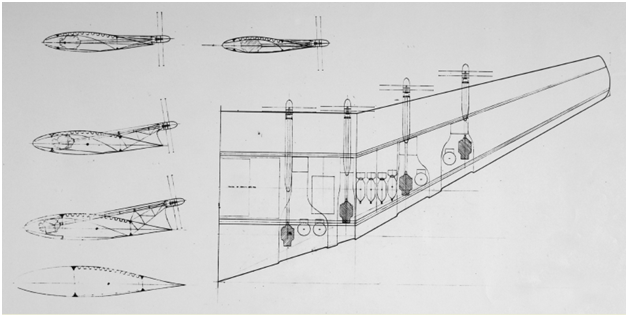
The structure of the wing Martin Model 236. The figure shows the Lycoming R-7755 engines and their placement options.
The Model 236 bomber was to receive a standard fuselage with a cylindrical section about 45 m in length, in which it was planned to place the crew cabins and a number of important units. In the nose fairing should be part of the electronic equipment. Immediately behind the equipment placed the nose landing gear compartment. To maximize the chassis base, as well as to maintain acceptable volumes for crew accommodation and equipment, the nose strut was pushed forward, which made it necessary to place the cleaning compartment inside the nose fairing.
Behind the chassis compartment should have been the cockpit. Free volumes allowed to make not only a cockpit with workplaces for pilots, but also a separate rest room with the necessary amenities that could be used during long flights. A curious feature of the cabin was the lack of a single windshield. Instead, two pilots, sitting side by side, were to use two separate lanterns of a “fighter” design. This idea was called bug-eyed ("bug eyes"). The entire central part of the fuselage was given under a relatively long cargo compartment for the transport of payload. The tail part of the fuselage was supposed to accommodate part of the equipment, defensive weapons, etc.
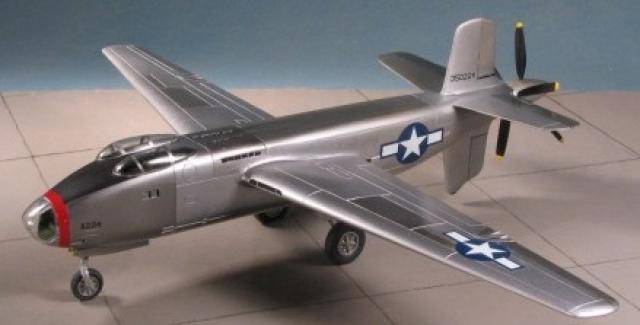
XB-42 - an example of using the "bug-eyed" scheme
Of particular interest is the design of the wing, proposed in the project Model 236. This aircraft was to be built according to the scheme of a free-carrying low-winged swept wing, but the latter should have a greater thickness and large internal volumes. From the available materials it is known that the wing of the new aircraft, the 60 scale, was to consist of two main parts: a center section and consoles. The center-plane had a smaller sweep and a straight rear edge, and was also constructed on the basis of two spars at right angles to the longitudinal axis of the aircraft. Wing consoles should have a large sweep and swept rear hem. Console spars were supposed to dock with the power units of the center section at an angle.
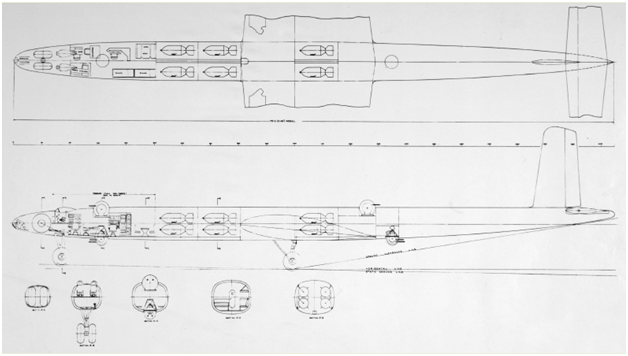
The structure of the fuselage Martin Model 236
The large relative thickness of the wing made it possible to place a number of necessary units in it. In addition to the "traditional" fuel tanks in the wing and planned to install the engines, and the power plant had to completely hide under the skin. In addition, in the root of the consoles provided additional cargo compartments to increase the bomb load on the 5 t.
Due to the lack of engines of sufficient power, Martin designers had to build a power plant based on a relatively large number of engines. For use on the Model 236 bomber, the Lycoming R-7755 piston engine and the Wright T-35 turboprop were considered. Both of these engines had power at the level of 5000 hp, which to some extent facilitated the development of the aircraft.
Eight engines were proposed to be placed inside the front of the wing. On Model 236 aircraft, push-in twin coaxial propellers should have been used. Engines and gearboxes screws connected by long shafts passing through the entire wing. Four engines were in the center section, four more - in consoles. In order to improve the characteristics of the axis of the screws should have been located at different angles to the horizontal. Thus, it was proposed to make the axes of the extreme engines almost horizontal, and as the fuselage approached, the angle was to increase. Thus, the shafts and screws of all engines had to be equipped with special supporting structures and fairings.
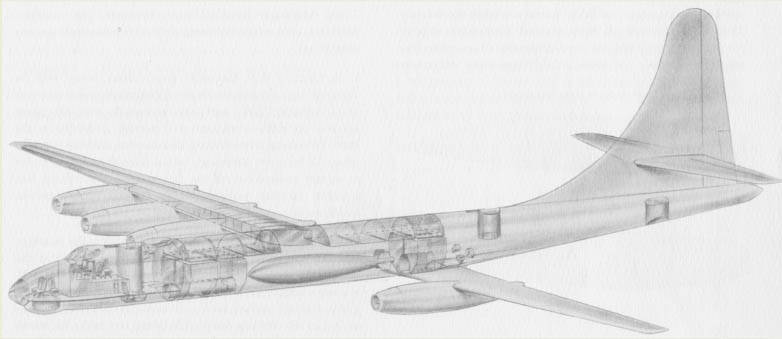
Boeing Model 462 - sectional view. In the bomb bay you can see the 20 ton bomb Т12[/ Center]
Given the seeming complexity, the proposed layout of the power plant not only provided acceptable traction, but also allowed the aircraft to maintain optimal balancing, concentrating sufficiently heavy engines near the center of gravity of the machine. The inclination of the propeller axles was probably proposed to improve the take-off and landing characteristics and improve the general aerodynamics of the aircraft.
For some not entirely understandable reasons, the Model 236 aircraft received tail, typical of the bomber old models. They were a stabilizer and a relatively high keel with a small sweep of the leading edge. Perhaps, in the future, the aircraft could get the arrow-shaped plumage, which corresponded to the requirements of time, but a less progressive version of the project was proposed for consideration by the military.
In the central part of the Martin Model 236 bomber's fuselage, a large cargo compartment with a length of about 17 m was designed, which was shifted to the nose. In the main fuselage cargo compartment, 18 tons of bombs could be transported. The two wings also contained 5 tons. Thus, the maximum payload of the proposed aircraft was one third less than the required technical specifications.
A promising bomber was supposed to get quite powerful defensive weapons. In the forward part of the fuselage and behind the wing were provided places for the installation of four gun turrets. These units were proposed to perform in the form of a spherical casing, inside which the guns were to be located. Each such cover was supposed to hold two automatic guns caliber 20 mm. Spherical corps turrets were partly located inside the corpus, like the lower turret of a B-17 bomber.
The Model 236 aircraft turned out to be quite heavy, although it was inferior in this parameter to competing bombers. With a normal combat load and fuel reserve, it had to weigh about 125 tons. Despite the lower take-off weight and comparable powerplant, the Martin aircraft was supposed to give way to competitors in a number of important characteristics. The developers managed to meet customer requirements for altitude, as well as to ensure maximum speed at the level of 700 km / h, which was slightly less than the specified 725 km / h. However, the car had serious problems with the range.
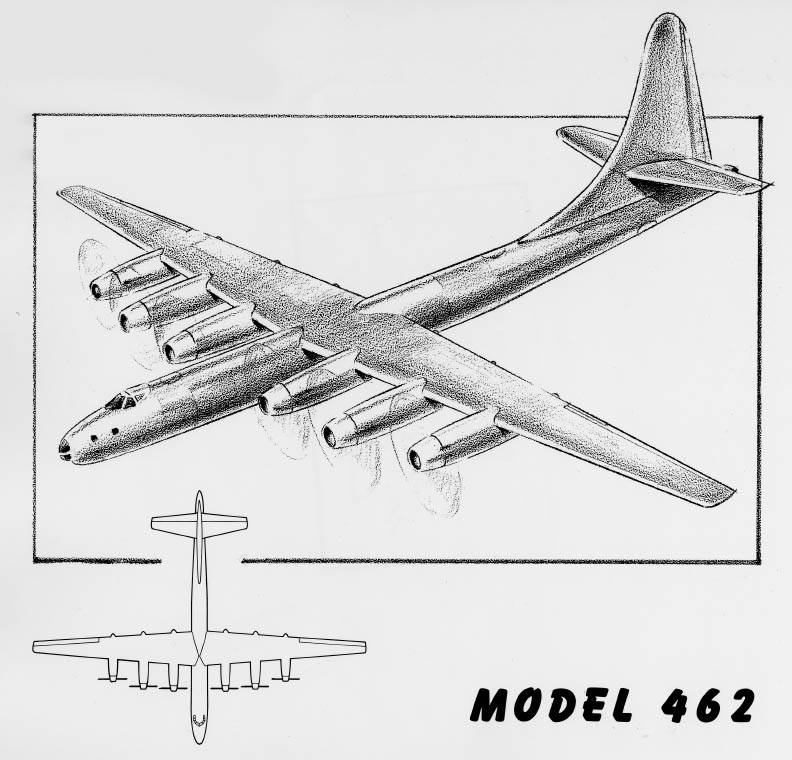
Illustration for the Boeing Model 462 brochure. In this illustration, the turret was removed.[/ Center]
Calculations and blowdown models showed that when flying at cruising speed, the flight range, even with the minimum required payload (4,5 t), will not exceed 3500 km. It was more than half the distance specified by the requirements. The project required serious refinement. It was necessary to seriously change the design of the aircraft in order to improve its aerodynamic characteristics.
At the beginning of 1946, the customer eased slightly the requirements for maximum flight range. Existing engines had excessive fuel consumption and did not allow to bring the range to the required level. However, even after such a refinement of the technical specifications, the Model 236 project did not suit the military. In the early spring of 46, the US Air Force summed up the preliminary results of the program: Martin dropped out of it. The project proposed by her was considered unpromising.
In the proposed form, the Model 236 project did not suit the customer. To remedy this situation, it was necessary to continue its development, introducing numerous changes to various structural elements. For example, to improve the flight performance, the tail structure should be radically changed. In addition, some parameters could be increased by reducing the relative thickness of the wing. Nevertheless, it should be noted that such improvements would be quite complicated and time consuming, and also would take a lot of time.
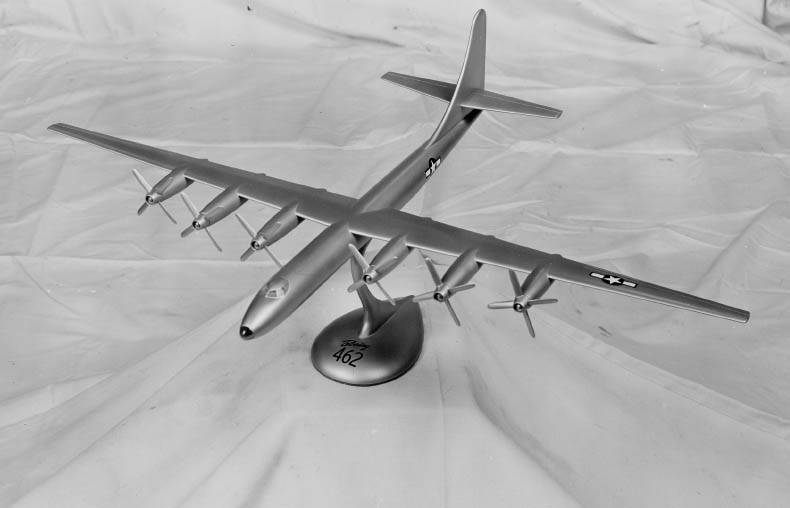
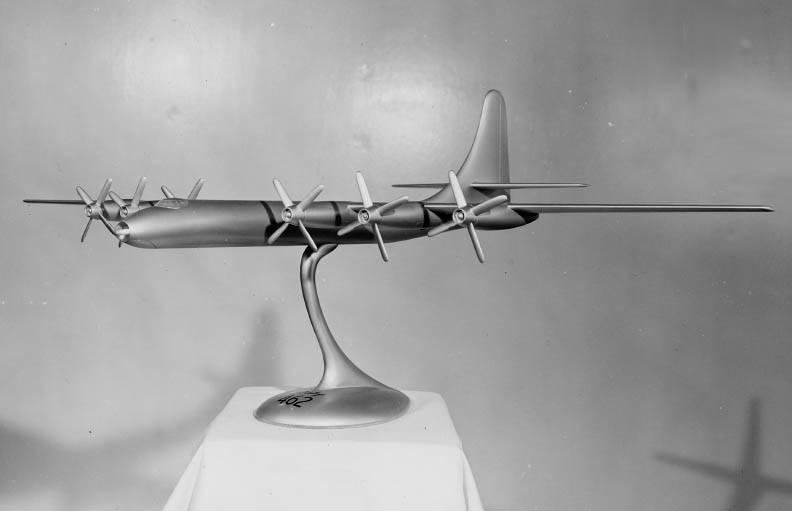
Scale model of the Boeing Model 462. Gun turrets removed[/ Center]
Thus, the military was faced with a rather difficult choice between two solutions: they could order the termination of all work on the Martin Model 236 project or demand to change it in order to increase the calculated characteristics. After weighing all the pros and cons of both options, the military chose the first option. The Model 236 project was discontinued in the absence of visible perspectives, and further competition went on between the Boeing Model 462 and Convair LRHBA projects.
According to some reports, Martin did not stop all work, but tried to use existing ideas in other projects. Some sources mention attempts to create a new bomber with extensive use of developments on the Model 236, as well as a certain design of the aircraft carrier "parasitic" fighters. Such a plane could carry several small fighters and escort groups of bombers, protecting them from enemy attacks. However, both new projects have not advanced further the start of design work.
On the materials of the sites:
http://alternathistory.org.ua/
http://forum.worldofwarplanes.ru/
http://globalsecurity.org/
http://secretprojects.co.uk/
http://hyperscale.com/
Information